Topics:
2025 Local Rules
Adjusting Scores for Posting at GC
site
Pace of Play
Golf Course Rating
Your Golf Handicap
Limits on Handicap Index
GGGC 2025 Local Rules
(in concurrence with the Official Guide to the Rules of Golf, specifically Rules 15-18)
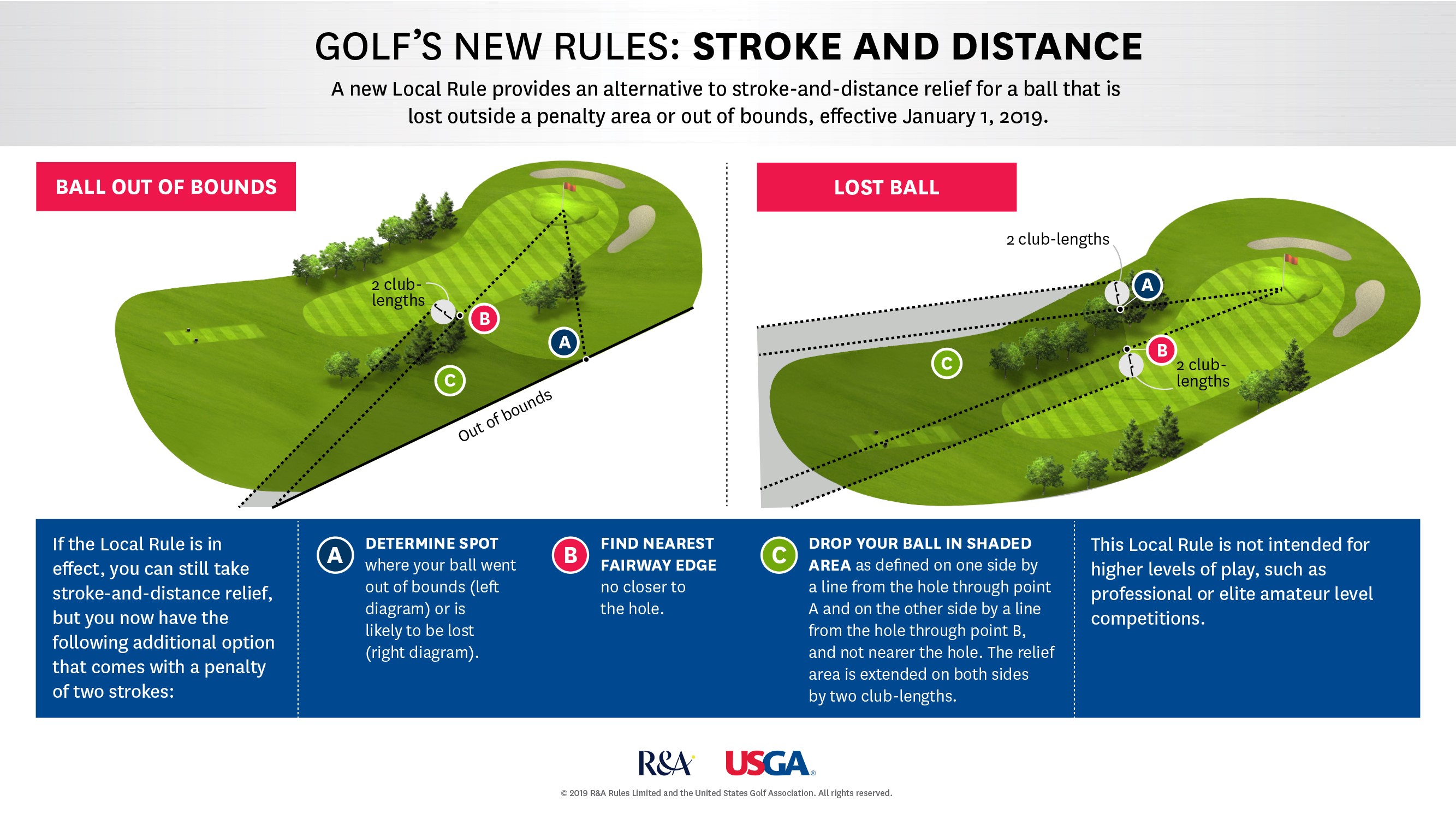
- Stroke and Distance (S&D) - Reference MLR E-5, an added option as endorsed by Golf Canada, R&A and USGA. Determine where your ball went OB or is likely to be lost. Find the nearest fairway edge and drop within 2 club lengths for S&D penalty (2 strokes). If a player decides to hit a provisional ball, then the S&D rule on the first ball is nullified. The player may decide to use S&D rule on the provisional if that ball is also lost or went OB adding 2 more strokes. It is therefore wise to just use S&D on the first ball rather than risk getting more penalty strokes. S&D is recommended to improve pace of play, hence do not go back to the tee box to replay a shot. Note that the rule is not intended for higher levels of play such as professional or elite amateur level competition.
- Out Of Bounds (OB) - Boundary fencing and white stakes throughout the course, including driving range (hole #2 and #9). Remember, no free relief if your ball is snuggled up against a boundary fence.
- Penalty Area (PA) - Red stakes which are movable obstructions. The entire area
beyond the red stakes on hole #2 (right side of the green), hole #7 (back and right of the green), and
hole
#17 (back of the green) are deemed to be part of the PA. Bridges on holes #14 and #15 are also part of the
Penalty Area.
- Holes with aquatic PAs - All Holes with aquatic PAs are marked in red. Ball entering the aquatic PA provides playing options:
- Option 1: Point where the ball crossed the PA, 2 club lengths not nearer the hole, one stroke penalty. As applicable to the hole, drop can also be as far back as you want on direct line to the pin (now known as “back-on-the-line” relief).
- Option 2: Replay the shot from original spot with applicable stroke penalty.
- New Trees - Stay clear of newly planted trees marked with long stakes and watering bags. Not nearer to the hole, take a free drop to ensure swing, stance, and line of sight relief. Note that there is no line of site relief from all other trees with guard fencing and/or flagging ribbons.
- Hole #15 - No play zone at the back of the green where the exotic shrubs reside. Drop zone on the grassy area to the left of the rock wall across the cart path. Free relief.
- Hole #11 - Chain-linked fence next to the tee box is to guard the airfield from errand shots. Golfers must replay the shot if the ball hits this fence just right of the tee box – no penalty.
- Green Power Boxes and Other Permanent Man-made Fixtures - Permanent man-made fixtures include wooden barriers, garden ties, power boxes and wooden fences. Full swing and stance relief not nearer the hole, but no relief for line of sight.
- White and Green Stakes - Short stubby stakes used by the maintenance crew as guides or ground markers. Please replace if you must move them to play a shot and don’t run them over with your carts.
- Orange & White Tee Markers on Fairways - Not rated and scores are not to be used for handicap purposes.
Above summarizes the areas golfers run into on a regular basis at Glacier Greens. Relief procedures on other PAs not mentioned (including red-staked ditches, aquatic, and lateral PAs) are to be followed in accordance with the Official Guide to the Rules of Golf.
If in doubt, record two scores on the scorecard and verify the correct ruling with the Pro Shop after the round.
Adjusting Scores for Posting at
Golf Canada Score Centre
Handicaps must be maintained throughout the season ensuring enough rounds played to reflect a player’s golfing ability and appropriate skill level. Below is the standard set out by the World Handicap System (WHS) which must be followed when posting your scores.
Adjusting Scores for Posting at the Golf Canada Score Centre - The Equitable Stroke Control (ESC) is used for handicap purposes. After a handicap index has been established, a net double bogey on any hole is the maximum allowed. In other words, count a maximum of two strokes over par plus (or minus) any handicap strokes you are entitled to, based on the stroke allowance for that hole - a hole’s Stroke Index Allocation (SIA).
For Example, if a player has a Glacier Greens course handicap of 8, he/she will:
- be allowed a max score of 3 strokes over gross par (2 strokes over par plus 1) on holes with SIA of 1 to 8 hcp. This would be on holes number 3, 5, 6, 9, 11, 13, 14, and 18.
- be allowed max score of 2 strokes over gross par (no stroke allowance) on remaining holes with SIA of 9 to 18 hcp. This would be on holes number 1, 2, 4, 7, 8, 10, 12, 15, 16 and 17.
For a plus hcp player (hcp of less than 0), strokes are given back starting at holes with highest SIA working in reverse order. For example if a player is +2 hcp, stroke allowance is a deduction on holes 12 and 4 (SIA of 18 & 17 hcp respectively), so his/her max score on those 2 holes will be a bogey (2 strokes over par minus 1). The remaining holes will just be max score of double bogey.
Conversely, for those with 19 hcp and higher, the max score of 2 strokes over par plus 2 is allotted starting on holes with lowest SIA working up. For example if a player is 20 hcp, his/her max score on holes 5 and 14 (SIA 1 & 2 hcp respectively) will be 4 strokes over gross par (2 strokes over par plus 2), while the remaining holes will just be max double bogey plus 1. For perspective, a player with 36 hcp will have max score allowance of double bogey plus 2 (4 strokes over par) on all 18 holes.
Ensure to adjust your score accordingly in order for ESC to be effective. You can avoid making the ESC calculations yourself by simply posting actual scores hole by hole on the Golf Canada site as the system will automatically make the adjustments for you. Notice that this system applies to nine hole rounds as well.
For more info on handicapping see: WHS Rules of Handicapping.
Pace of Play
Pace of play has been the number one cause of contention on the golf course and had created incidents where staff and advisory committee would step in to mitigate cases which could have been prevented. Glacier Greens asks that all players (members and guests) to be considerate and observe proper golf etiquette on the issue of pace of play.
Please remember:
- Let faster groups play through. Communicate politely, ask if you could play through and conversely ask if the group behind wants to play through. It is a two-way street.
- DO NOT hit balls into the group in front to get them to hurry up – it is not safe and this action could warrant disciplinary action.
- Four hours to play 18 holes is NOT a set standard. Players should not use this to justify their pace of play. Be mindful of the flow of traffic on the course and keep pace.
- We all have bad holes, loose balls, and end up falling behind. If you are having trouble keeping up with the group in front of you, check if you are holding up the group behind. Let groups play thru if that’s the case.
The bottom line here is to be courteous to other golfers. We all have bad days and good days on the course. Slow play seems to amplify anxiety and the root cause of conflicts and complaints.
Think of it as driving. Pay attention to the speed limit, let faster vehicles pass, and avoid road rage.
Keep calm and golf on.
Glacier Greens Golf Club Course Rating
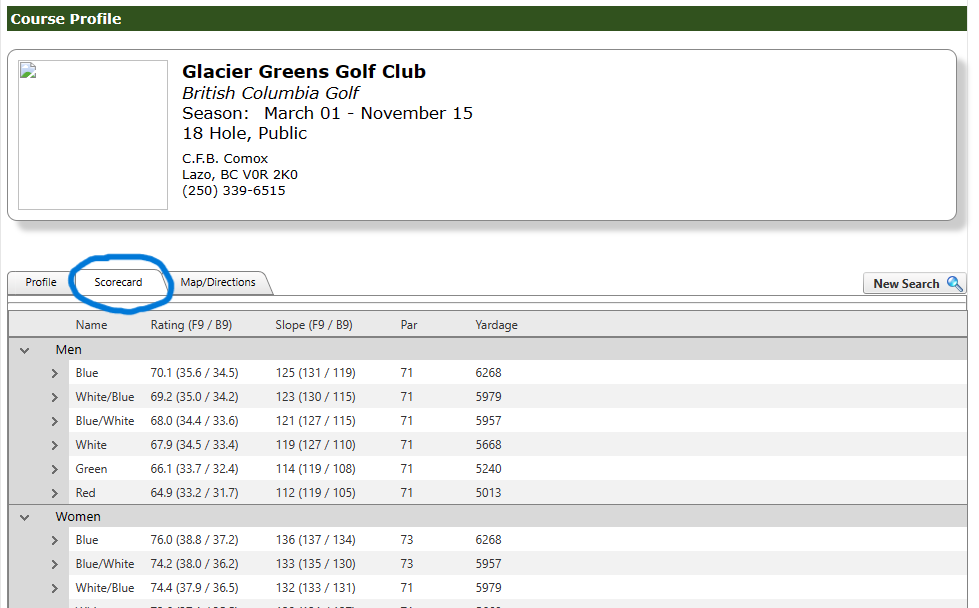

Click here to go directly to BCGA web page on Glacier Greens GC course rating; (or go to BCGA > Ratings & Handicaps then scroll down to “Golf Course Slope & Course Rating - search”, click ‘search’ then type in the name of the golf course).
On the Course Profile page, click on the Scorecard tab. The course slope and rating are displayed. Click on the drop-down arrow to see hole-by-hole yardage and HCP on the colour tee box you picked.
Your Golf Handicap
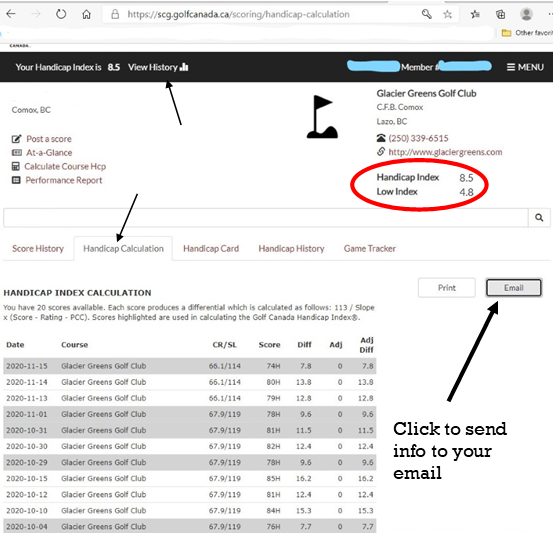
Allow me to draw your attention to Golf Canada Score Centre
(see the image on the right). When you click on “View History”
and then click on the ‘Handicap Calculation’ tab, this will give
you all the details you need about your handicap including:
• Hcp Index Calculation,
• Scores Used in the Calculation,
• Limits on Hcp Index Upward Movements,
• Adjusted Scores,
• Committee Adjustments, and
• Playing Conditions Calculation (PCC).
This ’Performance Report’ is a cool feature available to all members! Please check it out. They do a very good job with step by step illustration on how score adjustments are applied to the handicap. However if you need further explanation on how calculations are formulated, consult the rules under the World Handicap System which can also be found in this same site.
Golf terminologies we golfers use sometimes depends on who you ask. The aim is to have consistency in the interpretation. Below are commonly used terms found in your hcp report:
Handicap Index
The measure of a player’s demonstrated ability calculated against the Slope Rating of a golf course of
standard playing difficulty
(that is, a course with a Slope Rating of 113) (see WHS Rule 5.2).
Low Handicap Index
The lowest Handicap Index achieved by a player during the 365-day period (one year) preceding the day on which
the most
recent score in their scoring record was played (see WHS Rule 5.7).
IMPORTANT NOTE: A limit is set in order to control sudden rise in the Handicap Index in relation to the Low handicap Index within the 365-day period, they are called soft cap (a rise > 3.0 strokes) and hard cap (no more than 5.0 strokes after soft cap application). It is further explained in Rule 5.8 of the WHS manual.
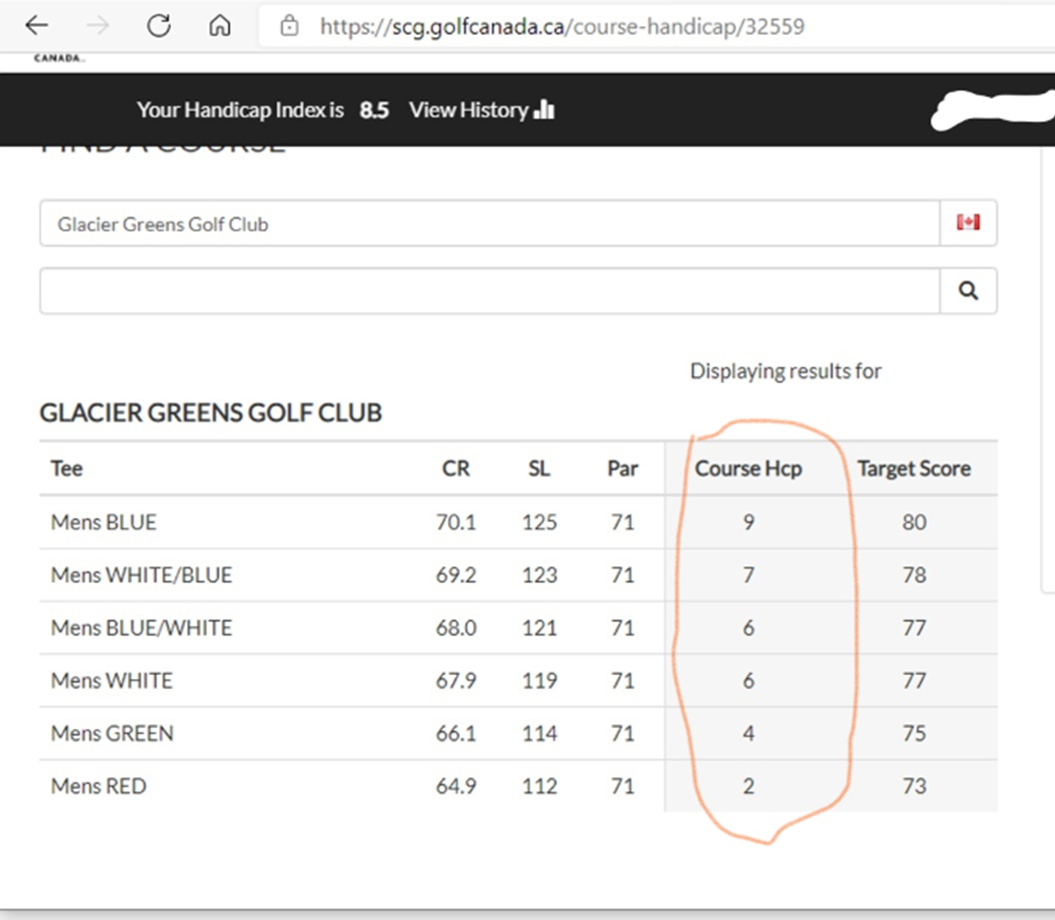
Principle of the Rule:
The Course Handicap calculation converts a Handicap Index to the number of strokes a player requires to play
any golf course
with a Course Rating and Slope Rating. This allows portability of a player’s Handicap Index wherever they
play. The Playing
Handicap calculation enables equity amongst players of all handicap levels within different formats of the
game. For formats of
play where a handicap allowance of 100% is adopted, the Playing Handicap will be the same as the Course
Handicap.
Course Handicap - For handicap purposes, a Course Handicap is used to determine the number of strokes that a player receives (or gives) on any golf course and for the correct application of net par and net double bogey adjustments (see Rule 6.1).
Playing Handicap - For equity purposes, the Playing Handicap calculation determines the number of strokes each player gives or receives, to ensure that all players can enjoy a fair and equal game when playing with or competing against one another (see Rule 6.2). Note: This is seldom used due to calculations involving handicap allowances - too much math for me ;-)
Review your ‘Performance Report’ from time to time as it gives you a better understanding of your playing ability and its fluctuations thru statistical data. Golf Canada will manage the numbers for you.
Limits on Handicap Index
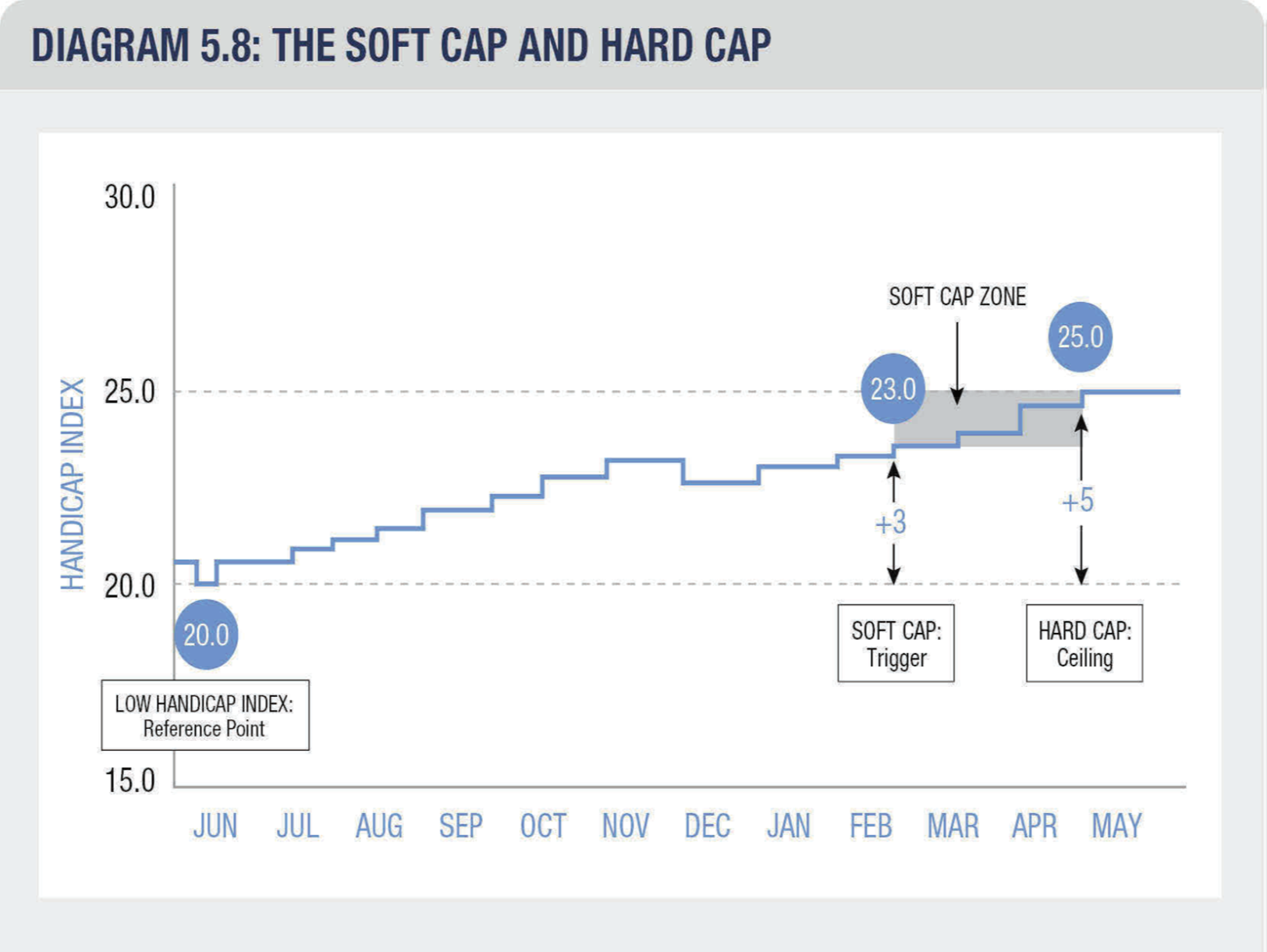
We are competitive by nature, some more than others and for those who can’t control the urge to go that extra distance in order to gain that inch of advantage, personal integrity and pride goes out the window.
The World Handicap System (WHS) is not full-proof against those who wish to manipulate and manufacture a handicap designed to disguise one’s real playing ability. We know that any system is cheatable, nevertheless, the ruling bodies do their best to keep honest golfers, well, honest. It is a game of honour after all. An added WHS feature in the Golf Canada score centre website to limit sudden rise in posted golf scores are the soft cap and hard cap. I touched on it on the previous issue of the newsletter. Rule 5.8 on WHS’s the Rules of Handicapping explains as follows:
Limit on Upward Movement of a Handicap Index
There are two trigger points within the cap procedure:
(i) The soft cap. The soft cap is triggered when the difference between a player’s newly calculated Handicap Index and their Low Handicap Index is greater than 3.0 strokes. When a calculated Handicap Index increase is greater than 3.0 strokes, the value above 3.0 strokes is restricted to 50% of the increase.
(ii) The hard cap. The hard cap triggers to restrict the amount by which a player’s Handicap Index can increase, after application of the soft cap, to no more than 5.0 strokes above their Low Handicap Index.
There is no limit on the amount by which a player’s Handicap Index can decrease. The soft cap and hard cap procedures start to take effect only after the Low Handicap Index has been established.
Recall that a Low Handicap Index is achieved by a player during the 365-day period (one year) preceding the day on which the most recent score in the scoring record was played. Some of you may notice why it has taken so long for your handicap to go up after all those crappy rounds you just played. Well, refer to your “Performance Report” in the Score Centre website where the limits on handicap index movement calculations are explained. Those crappy rounds will eventually catch up and hopefully reflect on your true golfing ability. On the other hand, a non-crappy round also known as exceptional score affects the handicap index sooner.
Until next time...please post your scores right after each round (hole by hole preferably).
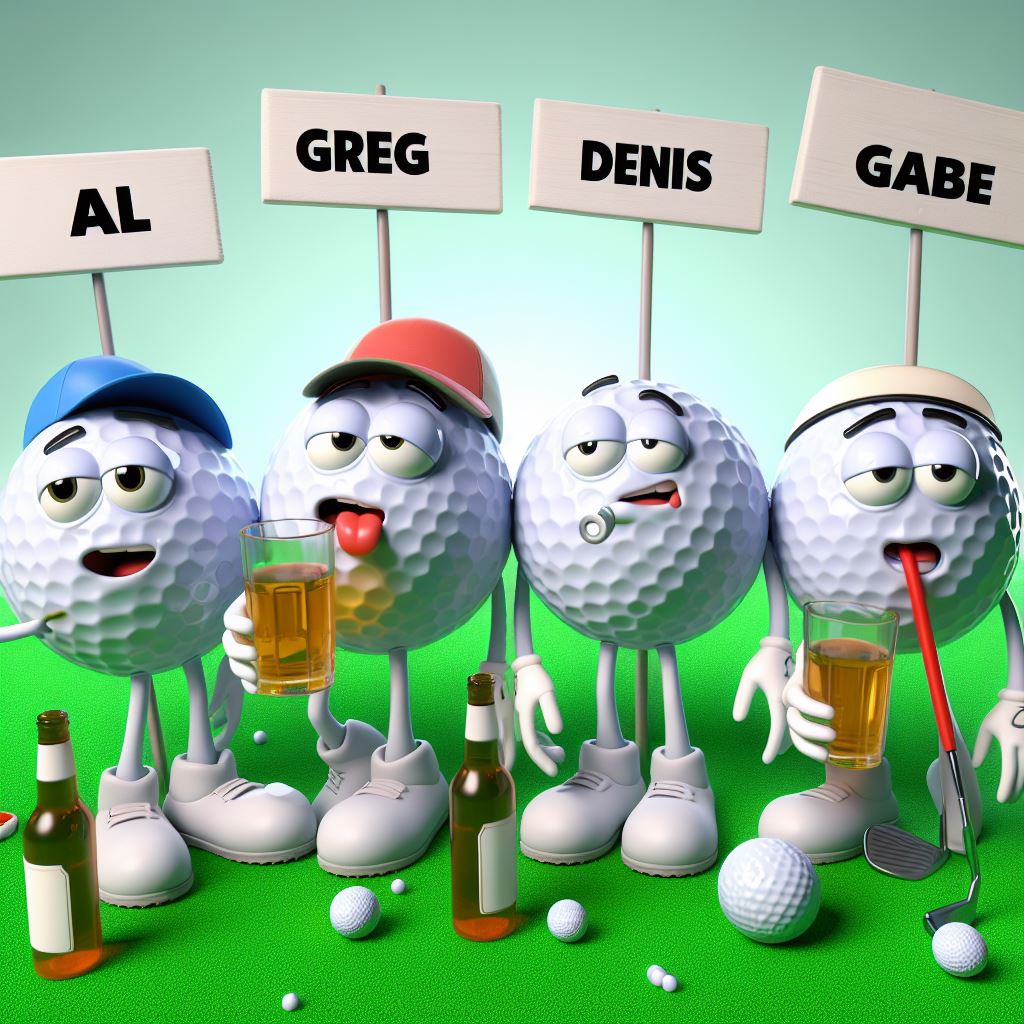
AWESOME FOURSOME
 Club Captain Info
Club Captain Info

 Top of Page
Top of Page